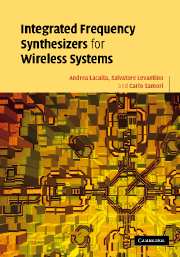1 - Local oscillator requirements
Published online by Cambridge University Press: 09 August 2009
Summary
Personal wireless communications have represented, for the microelectronic industry, the market with the largest growth rate in the last ten years. The key for such a boom has been the standardization effort made by several organizations and the replacement of compound semiconductors with silicon technology in building radio front ends. This advancement was made possible by joint progress in communication theory, devices technology and system and circuit design. Silicon technology made it possible to attain lower fabrication costs, owing to the large production volumes and to the possibility of implementing complex digital functions together with radio-frequency (RF) signal manipulations, lowering the number of off-chip components.
Initially in the 1990s, cellular systems have been the driving application for this technology evolution. Further generations of cellular telephones have introduced the possibility of communicating not only by voice but also with text messages, images and videos. Later, a number of wireless technologies have emerged, not strictly belonging to the class of communication systems. Some examples are wireless local-area networks (WLAN), sensor networks, wireless USB applications and automotive radar.
Table 1.1 summarizes various high-level characteristics of the most common communication standards. Despite the variety of modulation formats and access methods, the basic structure of a typical transceiver has remained as shown in Figure 1.1. In both the receiving and the transmitting branch, frequency conversions are performed to move the signal from the RF band to the base band and vice versa.
- Type
- Chapter
- Information
- Publisher: Cambridge University PressPrint publication year: 2007



